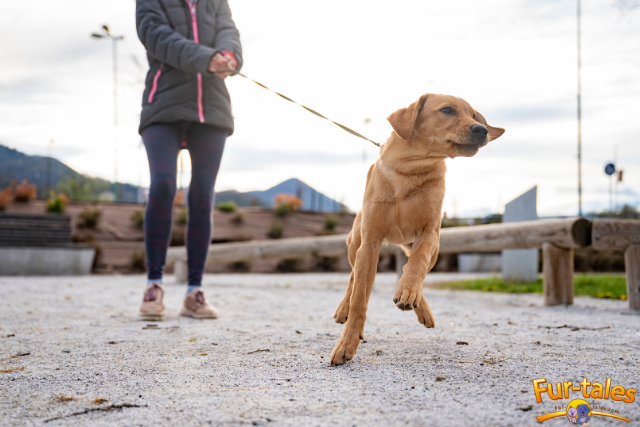
Leash Reactivity in Dogs: Understanding and Addressing It
Walking your dog should be a pleasant and bonding experience, but for many dog owners, it turns into a stressful event. If your dog barks, lunges, or growls at other dogs, people, or even cars while on a leash, you might be dealing with leash reactivity. This common issue affects countless dogs and can make daily walks challenging and frustrating.
Leash reactivity is often misunderstood. While it may look like aggression to outsiders, it’s usually rooted in fear, frustration, or overexcitement. Understanding this distinction is the first step in addressing the issue with empathy.
Fortunately, with understanding and the right strategies, leash reactivity can be managed and often significantly improved. This guide explores what leash reactivity is, why it happens, and how to address it with compassion and effectiveness. By learning to interpret your dog’s signals, you can turn stressful walks into positive experiences.
What is Leash Reactivity?
Leash reactivity refers to a dog’s intense and often aggressive-seeming behavior while on a leash when encountering specific triggers. These triggers might include:
- Other dogs
- Strangers
- Bikes or scooters
- Cars
- Wildlife
The behavior usually manifests as barking, lunging, growling, or pulling. Importantly, leash reactivity does not necessarily mean a dog is aggressive. Many reactive dogs are otherwise friendly when off-leash. The leash itself, which restricts natural movement and body language, often contributes to the reactive response.
Common Causes of Leash Reactivity
Understanding the underlying reasons for leash reactivity is crucial in addressing the issue effectively. Here are the most common causes:
1. Frustration and Overexcitement
Some dogs become frustrated when they cannot approach other dogs or people. This barrier frustration can escalate into reactive behaviors as a way of expressing their excitement or frustration.
2. Fear or Anxiety
For fearful dogs, being on a leash removes the option to flee, which may result in defensive behaviors like barking and lunging to keep perceived threats at a distance.
3. Lack of Socialization
Dogs that did not receive adequate socialization during their critical development periods may feel uneasy around new sights, sounds, and experiences, leading to reactivity.
4. Negative Past Experiences
A dog that has been attacked or frightened in the past may anticipate negative outcomes in similar scenarios and react aggressively as a preventive measure.
5. Genetic and Environmental Factors
Some breeds are naturally more prone to being alert or reactive. Combined with environmental influences, like a chaotic household or inconsistent training, this can contribute to leash reactivity.
Signs of Leash Reactivity
Leash reactivity may range from subtle signs to overt aggressive displays. Recognizing early warning signs can help you intervene before the situation escalates. These signs include:
- Stiff body posture
- Intense staring or “hard eyes”
- Growling or barking
- Lunging or pulling toward the trigger
- Raised hackles
How to Address Leash Reactivity
Addressing leash reactivity takes time, patience, and consistency. Here are effective strategies to help reduce this behavior:
1. Identify Triggers and Thresholds
Observe your dog closely to identify what triggers reactivity and from what distance the behavior begins. This distance is called the “threshold.” Working below this threshold is crucial during training to ensure your dog remains calm and receptive.
2. Use Positive Reinforcement
Reward calm behavior around triggers with treats, praise, or toys. This helps your dog form positive associations with the trigger. For example, if your dog sees another dog and remains calm, immediately reward them.
3. Implement Desensitization and Counter-Conditioning
Gradually expose your dog to triggers at a safe distance and pair the presence of the trigger with something positive. Over time, this can change your dog’s emotional response.
4. Teach Alternative Behaviors
Train your dog to perform alternative, incompatible behaviors when they see a trigger. Commands like “look at me,” “sit,” or “heel” can redirect their focus and prevent reactive outbursts.
5. Manage the Environment
Whenever possible, set up your walks to avoid triggers. Choose quiet routes and times of day when fewer people and dogs are around. Using barriers like parked cars or bushes can also help.
6. Use Proper Equipment
Consider using tools that give you better control without causing pain or discomfort, such as front-clip harnesses or head halters. Avoid choke chains or prong collars, which can increase fear and aggression. Comfortable, non-restrictive gear also helps reduce your dog’s stress levels during walks.
7. Be Patient and Realistic
Progress may be slow. Each dog learns at their own pace, and setbacks can happen. Consistency and gentle guidance are critical throughout the training process.
8. Seek Professional Help
For severe cases, working with a certified dog trainer or behaviorist can be invaluable. They can create a personalized training plan and guide you through the process safely and effectively.
Preventing Leash Reactivity in Puppies
Preventing leash reactivity is always easier than correcting it later. Here are tips for raising a well-adjusted and confident puppy:
- Provide plenty of positive socialization experiences.
- Teach basic obedience commands early on.
- Encourage calm behavior on walks.
- Avoid exposing your puppy to overwhelming situations.
Gradually exposing puppies to various sights and sounds while rewarding calm behavior builds confidence. Encourage positive interactions but always allow your puppy the choice to engage or retreat if overwhelmed.
FAQs About Leash Reactivity in Dogs
Q1: Is leash reactivity the same as aggression?
No. While leash reactivity can look aggressive, it often stems from fear, frustration, or excitement rather than true aggression.
Q2: Can leash reactivity be cured?
In many cases, leash reactivity can be significantly reduced or managed with consistent training. Some dogs may always require a bit of management, but improvement is very possible.
Q3: Should I punish my dog for being reactive?
No. Punishment can increase fear and anxiety, making the problem worse. Positive reinforcement and reward-based training are more effective and humane.
Q4: Does neutering or spaying help reduce reactivity?
While altering your dog can help with certain behavioral issues, leash reactivity is usually best addressed through training and behavior modification.
Q5: How long does it take to fix leash reactivity?
The timeline varies for each dog and depends on the severity of the behavior, consistency of training, and the owner’s commitment. Some see improvement within weeks, while others may take several months of ongoing work.
Image Designed Using Canva
